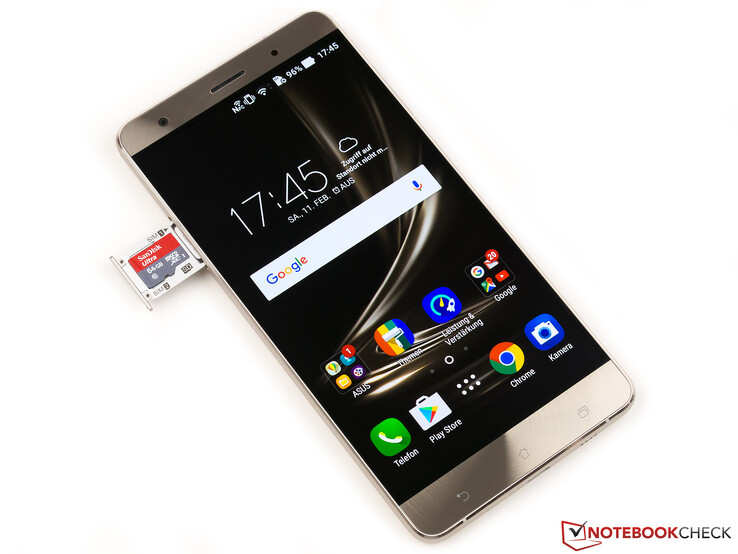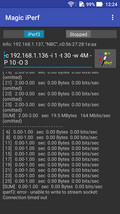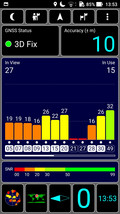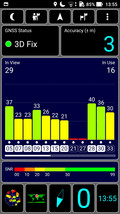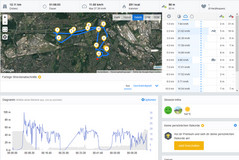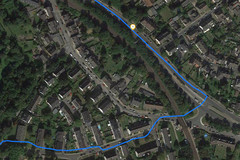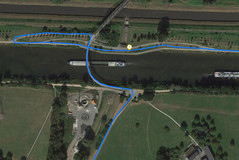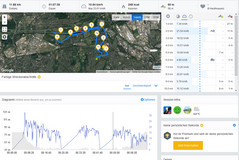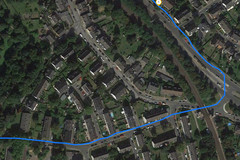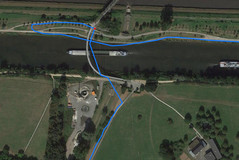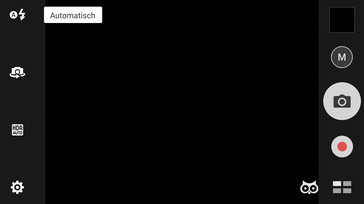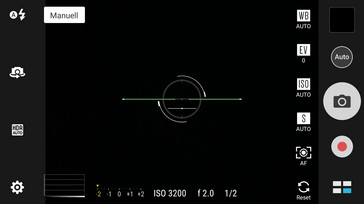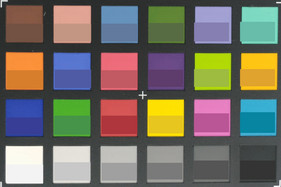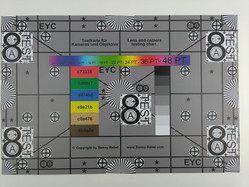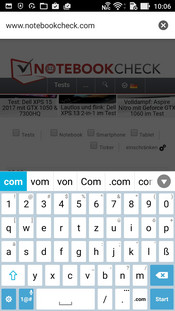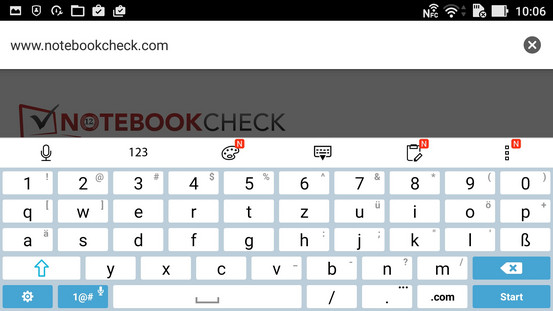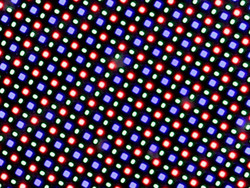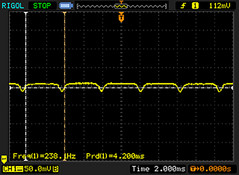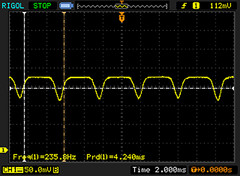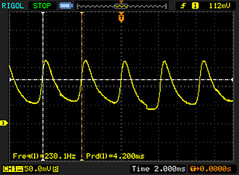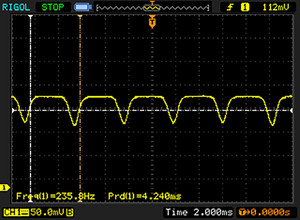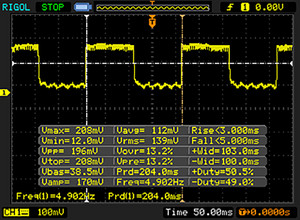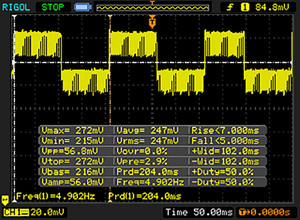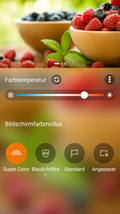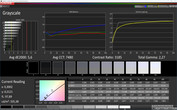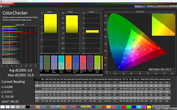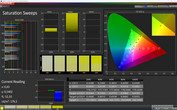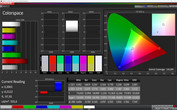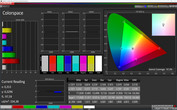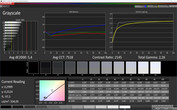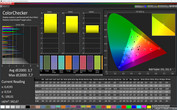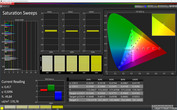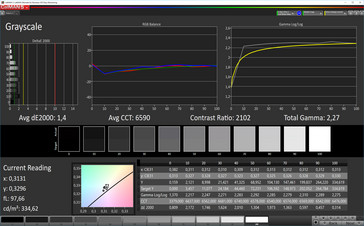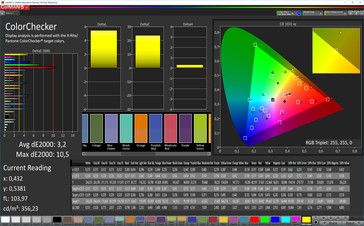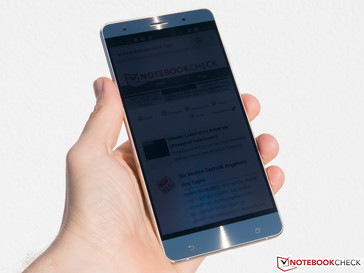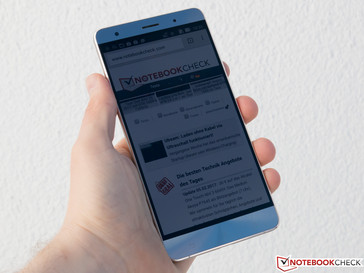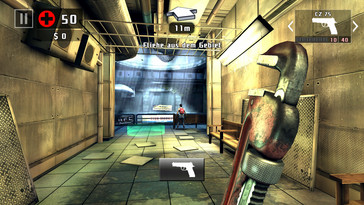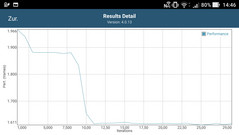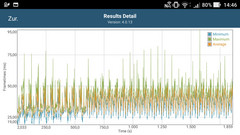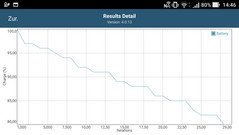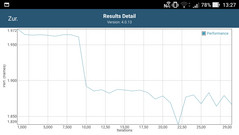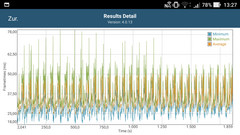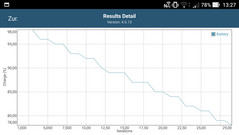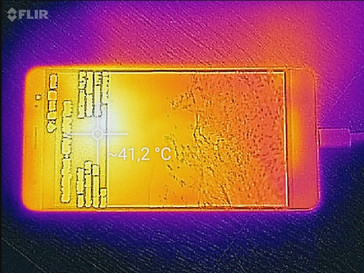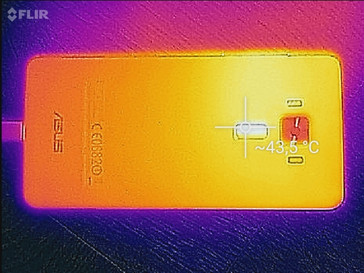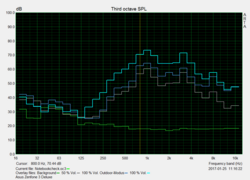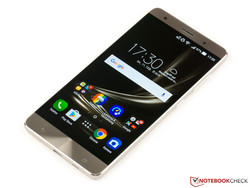Asus ZenFone 3 Deluxe ZS570KL Smartphone Review
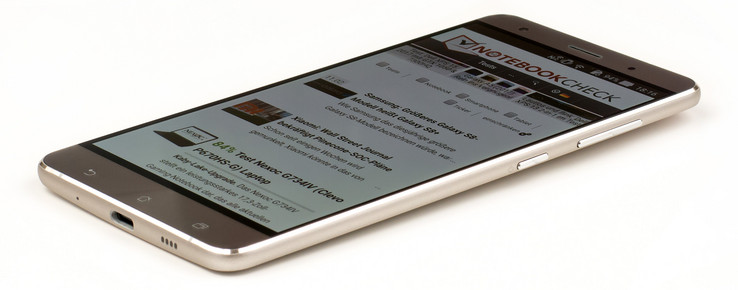
For the original German review, see here.
The ZenFone 3 Deluxe was introduced in May 2016 and has been available in Asia for about 6 months. It was the first device based on a Snapdragon 821 SoC at the time of its debut there. Today there are many competitive devices that are also equipped with this premium-range processor. Now, the smartphone is officially being launched in Europe. Its configuration makes it obvious that it is a flagship: Our review sample comes with a generous 128 GB of UFS 2.0 flash memory and 6 GB of RAM. The especially high-resolution 23-megapixel primary camera and a large 5.7-inch AMOLED panel are further features. The ZenFone 3 Deluxe will be available in Glacier Silver and Sand Gold at a starting price of 799 Euros (~$840).
The high-price and the incorporated high-end technology only allow using the premium models of competing manufacturers for comparison. Among them, we find the Android smartphones Samsung Galaxy S7 Edge, the Lenovo Moto Z and the Google Pixel XL with a 5.5-inch screen. However, the review sample also has to compete against the compact Huawei Mate 9 phablet with a 5.9-inch screen. Non-Android rivals fighting for the smartphone crown are found in Apple's iPhone 7 Plus and Microsoft's Lumia 950 XL.
Case
Asus is particularly proud of the ZenFone 3 Deluxe's aluminum casing that is not - as in most rivals - interrupted by antenna strips. They are only visible as three matte points in the milled edge around the front, covered by Gorilla Glass 4. The silver color of our review sample looks like champagne depending on the light angle. With a width of 156.4 millimeters (~6.2 in) and length of 77.4 millimeters (~3 in), it is not much bigger than Apple's iPhone 7 Plus or Lenovo's Moto Z with a 5.5-inch screen, despite its 5.7-inch panel. However, Huawei's Mate 9 scores with even more screen surface with similar dimensions. The review sample's maximum height of 7.7 millimeters (~0.3 in) corresponds roughly to Asus specifications (4.2 to 7.5 millimeters/~0.17 to ~0.3 in). The camera lens protrudes by approximately one millimeter (~0.04 in) and thus the smartphone rocks a little when placed on a table. Asus' minimum specification of 4.2 millimeters (~0.17 in) only applies to the outermost area between both glossy diamond cut edges and is thus not significant for everyday handling. With a weight of 161 grams (~5.7 oz), our review sample is even 11 grams (~0.4 oz) lighter than stated in the specification sheet. Furthermore, the handset gives the impression that it has been made of one piece: The smartphone absolutely defies twisting attempts and moderate pressure on both the front and the back.
The build quality does not leave much room for complaint either. All edges have been impeccably smooth, the materials feel high-quality, and the gaps between the different parts are narrow. Only the lateral buttons clatter somewhat when touched lightly. Apart from the removable card tray on the casing's left, there are no maintenance options and the user cannot replace the battery easily.
Connectivity
The generous 6 GB of RAM and 128 GB of storage make it obvious that the ZenFone 3 Deluxe is a premium-range smartphone. However, the operating system and preloaded applications occupy a large part of the latter, and the user ultimately has only 109 GB available. It is possible to insert a microSD card with the current maximum capacity of 256 GB that should provide more storage should it be needed (theoretically up to 2 TB). It cannot be formatted as internal storage and thus apps cannot be installed on it. Furthermore, this blocks the dual-SIM function since the microSD card slot shares the space with the second SIM slot.
A reversible USB Type-C is installed for recharging the battery and sharing data. While the ZenFone 3 Deluxe supposedly supports USB 3.0 according to some specification sheets, only 2.0 speeds were possible with our review sample. Although a USB 2.0 cable is included, no more than 35 MB/s could be transferred even with a USB 3.0 cable. It is nice that USB OTG is supported, which allows direct attachment of peripherals and flash drives or keyboards. Furthermore, the ZenFone 3 Deluxe supports video output via DLNA and Miracast. Wi-Fi Direct, NFC, and Bluetooth 4.2 are available for wireless data sharing. An FM radio is also installed.
An Always-On display and the notification LED allow the user to see information at a glance. However, the latter only lights up in orange and green. Configuration options are not available.
Software
Asus covers Android version 6.0.1 with its adapted user interface ZenUI 3.0. It is not known when or if an update to Android 7, which has already been available for a few months, will follow. Asus had started to deliver the corresponding update for the smaller ZenFone 3 in some regions a few days ago, but the rollout was stopped again shortly afterward. Asus also lags behind with security patches: Our review sample's was dated October 2016 - buyers could expect better support especially for a top model.
ZenUI 3.0 comes with a variety of functions - among them a theme engine that allows adapting the user interface's appearance extensively and quickly. Furthermore, a "Basic" and a "Kid's" mode that limit the smartphone's functions accordingly are installed. 50 items are found in the app drawer ex-factory; among them third-party apps from Facebook, Facebook Messenger, Instagram, Puffin, and TripAdvisor. Only the latter two can be uninstalled completely.
Communication and GPS
The ZenFone 3 Deluxe supports dual-SIM (1x nano-SIM, 1x micro-SIM). However, the second SIM slot is a hybrid slot that will possibly be occupied by a microSD card. All German mobile network frequencies are supported. Data transmission is possible at up to 600 MBit/s (download) and 100 MBit/s (upload) in the LTE network. However, only the SIM card set up for the data service can dial into them.
The ZenFone 3 Deluxe transmits in the latest Wi-Fi ac standard, and is also equipped with MIMO technology. Thus, gross data speeds of up to 867 MBit/s are possible. However, the connection with our Linksys EA8500 router recurrently was interrupted in the 5 GHz network and we could only perform reliable tests in the 2.4 GHz frequency band. With real transmission rates of 75.5 MBit/s in send and 70.4 MBit/s in receive, the ZenFone 3 Deluxe cannot keep up with other premium-range devices that we tested in the 5 GHz band. Furthermore, we noticed that the 5 GHz Wi-Fi range was not as good as with many other high-end rivals.
| Networking | |
| iperf3 transmit AX12 | |
| Apple iPhone 7 (Klaus I211) | |
| Google Pixel XL 2016 | |
| Samsung Galaxy S7 Edge | |
| OnePlus 3T | |
| Huawei Mate 9 | |
| Asus ZenFone 3 Deluxe ZS570KL | |
| iperf3 receive AX12 | |
| Apple iPhone 7 (Klaus I211) | |
| Google Pixel XL 2016 | |
| Samsung Galaxy S7 Edge | |
| Huawei Mate 9 | |
| OnePlus 3T | |
| Asus ZenFone 3 Deluxe ZS570KL | |
The ZenFone 3 Deluxe located our position with an accuracy of 3 meters (~10 ft) without significant delays outdoors. Indoors, this was at around 10 meters (~33 ft). The GPS, GLONASS, and BeiDou satellite networks are supported. Qualcomm's lZat location service can also be enabled optionally.
As usual, we took the review sample alongside Garmin's Edge 500 GPS system on a bike ride and logged the results. The smartphone does a relatively good job: The outcome of the total route recorded with both devices deviates by less than 2%, making the ZenFone 3 Deluxe quite suitable as a navigation system. In detail - for example, the crossing at the bridge just before the turning point in the west - most smartphones tend to take shortcuts.
Telephone and Call Quality
Asus does not use the standard Android phone software. Instead, a proprietary app is installed. It offers the standard features, such as a call list, keypad and direct access to the contact database. In addition, it can be fitted with a dark skin, a different background, and individual fonts to meet personal preferences.
The ZenFone 3 Deluxe convinces with good intelligibility and effective noise suppression during normal calls. However, a moderate background noise could occasionally be heard during the test. The strong speaker ensures decent clarity, even in hands-free mode, but recurrent short interruptions are heard on the contact’s side. The included headset also makes a useful impression: Both sides understand each other impeccably, and again, a slight noise is present only on the contact's side.
Cameras
The primary camera in the ZenFone 3 Deluxe has an aperture of f/2.0, optical image stabilizer and a high resolution of 23 megapixels. A laser and phase detection autofocus are used for focusing the picture as fast as possible. In practical use, this intricate system still functioned reliably to a large degree, even under difficult conditions. As our sample photos show (scene 1 & 2), lots of details could be captured with the high-resolution sensor in bright ambient light. However, a slight blurriness can be seen in the outer corners. Furthermore, some image areas present a certain graininess that becomes even more evident in poor light conditions. Smartphones with a lower resolution sensor are often superior to our review sample in low light situations. Asus has a trick up its sleeve, though: This shortcoming is hidden well via a special low-light mode that halves the photo's resolution horizontally and vertically. The opposite is the case in the super-resolution mode: Here, several photos are combined into one photo with twice the horizontal and vertical resolution of the automatic mode. This equates to a high 90.3 megapixels, even though Asus states 92 megapixels. In fact, landscape photos shot in this mode display a few more details. Overall, Asus has installed a primary camera suitable for the premium range. Its strength lies primarily in its high resolution under ideal conditions.
The smartphone's front-facing webcam has an 84-degree wide-angle lens with an aperture of f/2.2 and a resolution of 8 megapixels. This component does not give much reason for complaint: Relatively high-detail selfies can be taken in both good and bad light conditions - although inherently its resolution is lower than that of the primary camera.
The primary camera records videos with a maximum resolution of 3840x2160 pixels at 30 FPS. Videos at 60 frames per second are possible in Full HD quality. It is rather too bad that autofocus is disabled, and thus the touchscreen has to be used for changing the plane of focus. The front-facing camera records Full HD videos that are astonishingly focused for a selfie camera.
We compare a photo of X-Rite's ColorChecker Passport taken under defined light conditions with the factual reference colors to evaluate the color accuracy of the primary camera in the ZenFone 3 Deluxe. The photo is not edited afterward, e.g. a manual white balance. It is very obvious that the smartphone displays all colors more strongly and much brighter than they actually are. The latter is also true in the grayscale levels, but fortunately, here a color tint is not visible.
We test the sensor's resolution and reproduction performance by photographing our test chart under defined light conditions. The loss of sharpness at the edges and a visible graininess due to artifacts becomes even more apparent here than in the sample photos.
Accessories and Warranty
Asus delivers the ZenFone 3 Deluxe in a high-quality, stable box. It contains the smartphone, an 18-watt charger (5V, 2A or 9V, 2A), a USB 2.0 cable, an in-ear headset and a quick start guide. A custom made View Flip Cover is optionally available in black and beige for 49.99 EUR (~$53).
Asus includes a 12-month warranty on the smartphone. Of course, the legal warranty period of two years via the retailer applies within the EU. Please see our Guarantees, Return Policies and Warranties FAQ for country-specific information.
Input Devices and Handling
Gorilla Glass 4 protects the 5.7-inch touchscreen and allows accurate inputting. Quick typing on the proprietary ZenUI keyboard is possible. The keyboard also offers swipe input, makes word suggestions, and the user can customize its size and appearance.
The Android navigation buttons are implemented as backlit touch buttons below the screen in the ZenFone 3 Deluxe. They are very sensitive to the touch and their positioning saves valuable space on the screen compared with on-screen solutions. The smartphone generally responds stutter-free and without delays thanks to its high-end hardware.
It is also possible to use various touch gestures; among them, double-tap to wake and double-tap to sleep, as well as opening apps directly from standby. A finger has to draw a predefined letter on the disabled screen for this.
Obviously, a fingerprint scanner should not be missing in a top model. It is on the smartphone's back and is relatively small. It usually does its job without issues, but not quite as fast as the category leaders. The fingerprint is sometimes identified incorrectly.
Display
Asus has installed a 5.7-inch Super AMOLED panel with diamond matrix into the ZenFone 3 Deluxe. According to the manufacturer, it only needs an extremely narrow bezel. A specification of 1.3 millimeters (~0.05 in) is stated. However, we measured approximately 3.3 millimeters (~0.13 in) between the active screen surface and the outermost edge - not a bad rate, but not outstanding either.
With a resolution of 1920x1080 pixels and a pixel density of 386 PPI, the smartphone does not stand out positively in today's high-end sector - many competitors already use higher resolution QHD panels. Only Huawei's Mate 9 phablet has slightly less to offer here. Nevertheless, individual pixels can hardly be seen away from VR applications. When looking closer, light color fringing can be seen at the edges on single-colored surfaces.
The ZenFone 3 Deluxe achieves an average maximum brightness of 468 cd/m² with the ambient light sensor on a completely white surface. It even climbs up to 619 cd/m² when dark and bright areas are distributed evenly over the screen (average picture level / APL 50). On the other hand, a maximum of only 334 cd/m² is possible when adjusting the screen's brightness manually. These rates place the review sample roughly on par with Lenovo's Moto Z, but overall, cannot quite reach the level of Samsung's Galaxy S7 Edge or Huawei's Mate 9. Furthermore, the screen's illumination of 85% is not as homogeneous as in most rivals, even though this is not visible in practice. The black level is 0 cd/m² thanks to the underlying AMOLED panel technology, and thus high contrasts are achieved.
| |||||||||||||||||||||||||
Brightness Distribution: 85 %
Center on Battery: 619 cd/m²
Contrast: ∞:1 (Black: 0 cd/m²)
ΔE ColorChecker Calman: 3.2 | ∀{0.5-29.43 Ø4.77}
ΔE Greyscale Calman: 1.4 | ∀{0.09-98 Ø5}
Gamma: 2.27
CCT: 6590 K
| Asus ZenFone 3 Deluxe ZS570KL AMOLED, 1920x1080, 5.7" | Samsung Galaxy S7 Edge Super AMOLED, 2560x1440, 5.5" | Lenovo Moto Z AMOLED, 2560x1440, 5.5" | Huawei Mate 9 IPS, 1920x1080, 5.9" | Google Pixel XL 2016 AMOLED, 2560x1440, 5.5" | Apple iPhone 7 Plus IPS, 1920x1080, 5.5" | Microsoft Lumia 950 XL AMOLED, 2560x1440, 5.7" | |
|---|---|---|---|---|---|---|---|
| Screen | |||||||
| Brightness middle (cd/m²) | 464 | 554 19% | 485 5% | 696 50% | 402 -13% | 557 20% | 297 -36% |
| Brightness (cd/m²) | 468 | 552 18% | 490 5% | 680 45% | 408 -13% | 553 18% | 297 -37% |
| Brightness Distribution (%) | 85 | 96 13% | 92 8% | 93 9% | 85 0% | 97 14% | 93 9% |
| Black Level * (cd/m²) | 0.42 | 0.35 | |||||
| Colorchecker dE 2000 * | 3.2 | 1.59 50% | 2.1 34% | 4.3 -34% | 4 -25% | 1.4 56% | 2.67 17% |
| Colorchecker dE 2000 max. * | 10.5 | 2.56 76% | 5.5 48% | 9.4 10% | 10.1 4% | 3.1 70% | 3.98 62% |
| Greyscale dE 2000 * | 1.4 | 2.01 -44% | 2.6 -86% | 4.8 -243% | 3.2 -129% | 1.3 7% | 2.81 -101% |
| Gamma | 2.27 97% | 2.01 109% | 2.23 99% | 2.33 94% | 2.19 100% | 2.21 100% | 2.08 106% |
| CCT | 6590 99% | 6321 103% | 6843 95% | 7255 90% | 7037 92% | 6667 97% | 6379 102% |
| Color Space (Percent of AdobeRGB 1998) (%) | 82.12 | 88.14 | 63.1 | 66.31 | |||
| Color Space (Percent of sRGB) (%) | 99.98 | 100 | 99.83 | 99.79 | |||
| Contrast (:1) | 1657 | 1591 |
* ... smaller is better
Like virtually all AMOLED panels, the ZenFone 3 Deluxe uses PWM technology for controlling the brightness. The amplitude of switching cycles increases the darker the screen's brightness is set. It operates at a frequency of 235.8 Hz, which can cause eye problems or perception of screen flickering in sensitive users.
Screen Flickering / PWM (Pulse-Width Modulation)
| Screen flickering / PWM detected | 235.8 Hz | ||
The display backlight flickers at 235.8 Hz (worst case, e.g., utilizing PWM) . The frequency of 235.8 Hz is relatively low, so sensitive users will likely notice flickering and experience eyestrain at the stated brightness setting and below. In comparison: 53 % of all tested devices do not use PWM to dim the display. If PWM was detected, an average of 8083 (minimum: 5 - maximum: 343500) Hz was measured. | |||
Display Response Times
| ↔ Response Time Black to White | ||
|---|---|---|
| 8 ms ... rise ↗ and fall ↘ combined | ↗ 3 ms rise | |
| ↘ 5 ms fall | ||
| The screen shows fast response rates in our tests and should be suited for gaming. In comparison, all tested devices range from 0.1 (minimum) to 240 (maximum) ms. » 21 % of all devices are better. This means that the measured response time is better than the average of all tested devices (20.2 ms). | ||
| ↔ Response Time 50% Grey to 80% Grey | ||
| 12 ms ... rise ↗ and fall ↘ combined | ↗ 7 ms rise | |
| ↘ 5 ms fall | ||
| The screen shows good response rates in our tests, but may be too slow for competitive gamers. In comparison, all tested devices range from 0.165 (minimum) to 636 (maximum) ms. » 24 % of all devices are better. This means that the measured response time is better than the average of all tested devices (31.6 ms). | ||
The screen's color reproduction can be adapted via the app "Splendid". Asus sets the color profile to "Super Color" ex-factory. It delivers rich, cool colors and seems to be geared to the AdobeRGB color space. The setting "Standard" is aimed more at the more common sRGB color space and reduces the color saturation visibly. Nevertheless, the color temperature of 7518 K remains clearly over the ideal rate of 6500 K. We could reduce the color temperature to almost ideal 6590 K by pushing the corresponding slider in "Super Color" mode. At the same time, the DeltaE rates also dropped to 3.2 (colors) and 1.4 (grayscale).
Performance
Qualcomm's current premium Snapdragon 821 SoC is inside the ZenFone 3 Deluxe. Two of the quad-core's high-performance Kyro cores clock at a maximum of 2.4 GHz, while the other two clock at a maximum of 1.6 GHz. An Adreno-530-GPU is responsible for calculating graphics.
While the review sample is surprisingly far back in the chart, especially in the Geekbench 4 single and multi-core tests - even the Moto Z with its Snapdragon 820 chip limited to 1.8 GHz is not much worse - only the iPhone can put up a fight for the top position in the AnTuTu benchmark. The ZenFone is particularly impressive in all graphics tests: The combination of the high-performance graphics core and moderate screen resolution pay off visibly here. The subjective system performance is beyond reproach even if Huawei's Mate 9 and Lenovo's Moto Z reaps in approximately 50% more points in the PCMark Work Performance score.
| AnTuTu v6 - Total Score (sort by value) | |
| Asus ZenFone 3 Deluxe ZS570KL | |
| Samsung Galaxy S7 Edge | |
| Lenovo Moto Z | |
| Huawei Mate 9 | |
| Google Pixel XL 2016 | |
| Apple iPhone 7 Plus | |
| Microsoft Lumia 950 XL | |
| PCMark for Android - Work performance score (sort by value) | |
| Asus ZenFone 3 Deluxe ZS570KL | |
| Samsung Galaxy S7 Edge | |
| Lenovo Moto Z | |
| Huawei Mate 9 | |
| Google Pixel XL 2016 | |
| GFXBench 3.0 | |
| 1920x1080 1080p Manhattan Offscreen (sort by value) | |
| Asus ZenFone 3 Deluxe ZS570KL | |
| Samsung Galaxy S7 Edge | |
| Lenovo Moto Z | |
| Huawei Mate 9 | |
| Google Pixel XL 2016 | |
| Apple iPhone 7 Plus | |
| Microsoft Lumia 950 XL | |
| on screen Manhattan Onscreen OGL (sort by value) | |
| Asus ZenFone 3 Deluxe ZS570KL | |
| Samsung Galaxy S7 Edge | |
| Lenovo Moto Z | |
| Huawei Mate 9 | |
| Google Pixel XL 2016 | |
| Apple iPhone 7 Plus | |
| Microsoft Lumia 950 XL | |
| GFXBench 3.1 | |
| 1920x1080 Manhattan ES 3.1 Offscreen (sort by value) | |
| Asus ZenFone 3 Deluxe ZS570KL | |
| Samsung Galaxy S7 Edge | |
| Lenovo Moto Z | |
| Huawei Mate 9 | |
| Google Pixel XL 2016 | |
| Apple iPhone 7 Plus | |
| on screen Manhattan ES 3.1 Onscreen (sort by value) | |
| Asus ZenFone 3 Deluxe ZS570KL | |
| Samsung Galaxy S7 Edge | |
| Lenovo Moto Z | |
| Huawei Mate 9 | |
| Google Pixel XL 2016 | |
| Apple iPhone 7 Plus | |
The scores in the browser tests are mixed: While only the exceptionally powerful iPhone 7 Plus once again defeats the ZenFone 3 Deluxe in the Mozilla Kraken benchmark, it comes in last in the WebXPRT 2015 test. The Octane V2 and JetStream 1.1 scores are enough for the midfield.
However, considering that the top models of every manufacturer are competing against each other, the performance of the ZenFone 3 Deluxe is very high on its own. Browsing on the Internet is naturally possible without prolonged waiting times or annoying stutters.
| Mozilla Kraken 1.1 - Total (sort by value) | |
| Asus ZenFone 3 Deluxe ZS570KL | |
| Samsung Galaxy S7 Edge | |
| Lenovo Moto Z | |
| Huawei Mate 9 | |
| Google Pixel XL 2016 | |
| Apple iPhone 7 Plus | |
| Microsoft Lumia 950 XL | |
| Octane V2 - Total Score (sort by value) | |
| Asus ZenFone 3 Deluxe ZS570KL | |
| Samsung Galaxy S7 Edge | |
| Lenovo Moto Z | |
| Huawei Mate 9 | |
| Google Pixel XL 2016 | |
| Apple iPhone 7 Plus | |
| Microsoft Lumia 950 XL | |
| WebXPRT 2015 - Overall (sort by value) | |
| Asus ZenFone 3 Deluxe ZS570KL | |
| Samsung Galaxy S7 Edge | |
| Lenovo Moto Z | |
| Huawei Mate 9 | |
| Google Pixel XL 2016 | |
| Apple iPhone 7 Plus | |
| Microsoft Lumia 950 XL | |
| JetStream 1.1 - Total Score (sort by value) | |
| Asus ZenFone 3 Deluxe ZS570KL | |
| Samsung Galaxy S7 Edge | |
| Lenovo Moto Z | |
| Huawei Mate 9 | |
| Google Pixel XL 2016 | |
| Apple iPhone 7 Plus | |
| Microsoft Lumia 950 XL | |
* ... smaller is better
Asus has equipped the ZenFone 3 Deluxe with 128 GB of fast UFS 2.0 storage. It achieves a high performance especially in sequential write (163.05 MB/s) and random read (100.87 MB/s) that only the Moto Z can outperform. The outcomes in sequential read and random write are only enough for the midfield in the comparison group.
Accessing our Exceria Pro M401 (THN-M401S0640E2, UHS-I Class 3, max. read: 95 MB/s, max. write: 80 MB/s) was performed at 77.77 MB/s in read and 59.04 MB/s were possible in write. Although the memory card's potential is not quite exhausted, the ZenFone scores extremely well compared with the competition, especially in write.
| Asus ZenFone 3 Deluxe ZS570KL | Samsung Galaxy S7 Edge | Lenovo Moto Z | Huawei Mate 9 | Google Pixel XL 2016 | Apple iPhone 7 Plus | Microsoft Lumia 950 XL | |
|---|---|---|---|---|---|---|---|
| AndroBench 3-5 | |||||||
| Random Read 4KB (MB/s) | 100.9 | 86.7 -14% | 117.2 16% | 94.7 -6% | 87.7 -13% | ||
| Random Write 4KB (MB/s) | 14.55 | 15.79 9% | 74.9 415% | 8.77 -40% | 14.56 0% | ||
| Sequential Write 256KB (MB/s) | 163.1 | 145.1 -11% | 168.3 3% | 142.9 -12% | 83.4 -49% | ||
| Sequential Read 256KB (MB/s) | 409 | 487.3 19% | 439.7 8% | 594 45% | 258.2 -37% | ||
| Sequential Write 256KB SDCard (MB/s) | 59 | 50.4 -15% | 45.64 -23% | 29.53 -50% | |||
| Sequential Read 256KB SDCard (MB/s) | 77.8 | 76.4 -2% | 78.5 1% | 54 -31% | |||
| BaseMark OS II | |||||||
| Memory (Points) | 2051 | 2072 1% | 2190 7% | 3850 88% | 1677 -18% | 1319 -36% | 1945 -5% |
Games
Games
The fast Adreno 530 GPU in conjunction with the moderate Full HD resolution for a screen in a high-end handset has plenty of power reserves. We measured an average of 59 frames per second in "Dead Trigger 2", while "Asphalt 8" reached very high 30 FPS in both very low and high graphics settings - the latter indicates a frame rate limitation of the game. However, micro-stutters were recurrently observed when tapping the Nitro button in "Asphalt 8" despite the review sample's high performance. As we did not detect this behavior in any of the other apps, we presume that the game had a bug.
The large touchscreen and internal sensors functioned impeccably in gaming mode. However, the speaker on the side could be covered depending on the hands' positioning.
| Asphalt 8: Airborne | |||
| Settings | Value | ||
| high | 30 fps | ||
| very low | 30 fps | ||
| Dead Trigger 2 | |||
| Settings | Value | ||
| high | 59 fps | ||
Emissions
Temperature
The idle surface temperatures of roughly 28 °C (~82 °F) on the ZenFone 3 Deluxe are inconspicuous. The entire smartphone heats up moderately during load, and a maximum of only 40.9 °C (~106 °F) is reached. Although this feels slightly warmer due to the metal casing, it is uncritical for the inner components.
We use the battery test of GFXBench that performs the demanding Manhattan test thirty times in succession to examine whether this outcome involves performance losses. Here, it becomes obvious that it makes quite a difference whether one follows Asus' recommendation to enable the performance mode in the energy-savings settings or not. The SoC's performance decreases from the top rate by 18% after 8 runs and remains at this level. However, when the performance mode is selected, the loss of almost 7% is much lower.
(±) The maximum temperature on the upper side is 40.9 °C / 106 F, compared to the average of 35.2 °C / 95 F, ranging from 21.9 to 247 °C for the class Smartphone.
(+) The bottom heats up to a maximum of 39.7 °C / 103 F, compared to the average of 34 °C / 93 F
(+) In idle usage, the average temperature for the upper side is 28 °C / 82 F, compared to the device average of 32.9 °C / 91 F.
Speaker
Asus states that it has installed a special 5-magnet speaker design that is especially strong into the ZenFone 3 Deluxe. However, our Pink Noise assessment is not particularly high at a maximum of 78.9 dB(A). Nevertheless, the subjective sound when playing music is loud enough to fill small rooms with sufficient sound and without significant distortions. The handset sounds relatively thin as typical for smartphones, which is illustrated by the Pink Noise frequency curve: It drops audibly toward both the trebles and low tones. Thus, the speaker should be sufficient for many users in everyday use, but it cannot quite compete with the best sound solutions in the mobile sector.
The metal finish of the included 3.5-mm jack looks attractive, but music sounds very bass-heavy and muffled ex-factory. Fortunately, the preloaded audio assistant provides an equalizer and, with a few tweaks, a more balanced sound impression can be achieved.
Asus ZenFone 3 Deluxe ZS570KL audio analysis
(±) | speaker loudness is average but good (78.9 dB)
Bass 100 - 315 Hz
(-) | nearly no bass - on average 19.9% lower than median
(±) | linearity of bass is average (14% delta to prev. frequency)
Mids 400 - 2000 Hz
(±) | higher mids - on average 8.1% higher than median
(±) | linearity of mids is average (9.7% delta to prev. frequency)
Highs 2 - 16 kHz
(±) | higher highs - on average 5.8% higher than median
(±) | linearity of highs is average (13.5% delta to prev. frequency)
Overall 100 - 16.000 Hz
(±) | linearity of overall sound is average (28.9% difference to median)
Compared to same class
» 76% of all tested devices in this class were better, 3% similar, 21% worse
» The best had a delta of 11%, average was 35%, worst was 134%
Compared to all devices tested
» 86% of all tested devices were better, 2% similar, 11% worse
» The best had a delta of 4%, average was 24%, worst was 134%
Samsung Galaxy S7 Edge audio analysis
(+) | speakers can play relatively loud (88.7 dB)
Bass 100 - 315 Hz
(-) | nearly no bass - on average 27.4% lower than median
(±) | linearity of bass is average (8.7% delta to prev. frequency)
Mids 400 - 2000 Hz
(+) | balanced mids - only 4.4% away from median
(+) | mids are linear (4.7% delta to prev. frequency)
Highs 2 - 16 kHz
(±) | higher highs - on average 5.8% higher than median
(+) | highs are linear (6.2% delta to prev. frequency)
Overall 100 - 16.000 Hz
(±) | linearity of overall sound is average (20.6% difference to median)
Compared to same class
» 36% of all tested devices in this class were better, 9% similar, 55% worse
» The best had a delta of 11%, average was 35%, worst was 134%
Compared to all devices tested
» 54% of all tested devices were better, 8% similar, 38% worse
» The best had a delta of 4%, average was 24%, worst was 134%
Frequency diagram in comparison (checkboxes above can be turned on/off!)
Energy Management
Power Consumption
The power consumption shows that the ZenFone 3 Deluxe is equipped with high-performance components as it is higher than that of all rivals, especially during full load. The review sample is defeated by Google Pixel XL that is also powered by a Snapdragon 821 SoC in the direct comparison in every single measurement. However, the rival also has only to supply a smaller 5.5-inch AMOLED screen with power.
| Off / Standby | |
| Idle | |
| Load |
|
Key:
min: | |
| Asus ZenFone 3 Deluxe ZS570KL 3000 mAh | Samsung Galaxy S7 Edge 3600 mAh | Lenovo Moto Z 2600 mAh | Huawei Mate 9 4000 mAh | Google Pixel XL 2016 3450 mAh | Apple iPhone 7 Plus 2915 mAh | Microsoft Lumia 950 XL 3340 mAh | |
|---|---|---|---|---|---|---|---|
| Power Consumption | 11% | 22% | -20% | 23% | -19% | -113% | |
| Idle Minimum * (Watt) | 0.85 | 0.63 26% | 0.66 22% | 0.78 8% | 0.53 38% | 0.77 9% | 2.85 -235% |
| Idle Average * (Watt) | 1.2 | 1.1 8% | 1.01 16% | 2.13 -78% | 1.07 11% | 2.04 -70% | 2.95 -146% |
| Idle Maximum * (Watt) | 1.25 | 1.56 -25% | 1.09 13% | 2.17 -74% | 1.12 10% | 2.24 -79% | 3.26 -161% |
| Load Average * (Watt) | 6.97 | 5.95 15% | 3.97 43% | 6.32 9% | 5.53 21% | 4.69 33% | 8.92 -28% |
| Load Maximum * (Watt) | 9.74 | 6.7 31% | 8.34 14% | 6.49 33% | 6.26 36% | 8.66 11% | 9.39 4% |
* ... smaller is better
Battery Runtime
The ZenFone 3 Deluxe is equipped with only an averagely sized 3000-mAh battery considering the screen diagonal. The minimum runtime is relatively short due to the highest load energy requirement in the comparison field. Even Microsoft's Lumia 950 XL, equipped with a not very efficient Snapdragon 810 SoC, lasts half an hour longer in this scenario. At least the outcome is midfield in the realistic Wi-Fi test and when playing our test video with 463 and 799 minutes, respectively.
Asus provides some options for saving energy in the energy settings. For example, it is possible to disable data connections in standby or to limit the CPU performance.
In the ideal case, the battery is fully recharged within one and a half hours with the included 18-watt power supply. The battery is recharged by approximately 60% after 35 minutes should the user be in a hurry.
| Asus ZenFone 3 Deluxe ZS570KL 3000 mAh | Samsung Galaxy S7 Edge 3600 mAh | Lenovo Moto Z 2600 mAh | Huawei Mate 9 4000 mAh | Google Pixel XL 2016 3450 mAh | Apple iPhone 7 Plus 2915 mAh | Microsoft Lumia 950 XL 3340 mAh | |
|---|---|---|---|---|---|---|---|
| Battery runtime | 63% | 23% | 35% | 5% | 28% | -11% | |
| Reader / Idle (h) | 23.2 | 27.7 19% | 22.9 -1% | 25.6 10% | 22.2 -4% | 30.6 32% | 18 -22% |
| H.264 (h) | 13.3 | 15.2 14% | 12.1 -9% | 15.8 19% | 8.4 -37% | 13.6 2% | 10.2 -23% |
| WiFi v1.3 (h) | 7.7 | 12.2 58% | 6.8 -12% | 12.6 64% | 8.4 9% | 9.8 27% | 6.2 -19% |
| Load (h) | 2.5 | 6.5 160% | 5.3 112% | 3.7 48% | 3.8 52% | 3.8 52% | 3 20% |
Pros
Cons
Verdict
Already the feel of Asus' ZenFone 3 Deluxe is pleasing when held for the first time, thanks to its high-quality and particularly solid metal casing. This conceals a 128 GB UFS 2.0 storage and generous 6 GB of RAM besides the Snapdragon, and thus the smartphone is quite capable of competing with other high-end devices from 2016 in terms of performance. The connectivity with a USB Type-C port, optional Always-On display and a dual-SIM/microSD hybrid slot, among other things, is also appropriate. Both high-resolution cameras can reap in bonus points. Furthermore, the primary camera benefits from an especially fast autofocus system. However, it has some room for improvement, particularly in low-light situations and the often grainy picture texture. The high-resolution AMOLED panel's size of 5.7 inches is big, but the handset is only partially suitable for VR applications due to the Full HD resolution. Asus' modified ZenUI 3.0 user interface offers various extra functions - but not every user will like the fact that 19 GB of the admittedly relatively generous storage capacity is reserved. Furthermore, some rivals offer considerably longer battery life.
Users who do not need virtual reality capabilities and like the extensively modified user interface will find a high-quality premium-range smartphone with only a few real shortcomings in Asus' ZenFone 3 Deluxe.
However, it is debatable whether the review sample has enough highlights to justify the current starting price of 799 Euros (~$840), especially when compared to the now falling prices of the rivals. It cannot serve with a curved edge like Samsung's Galaxy S7 Edge or with the modular extensions of Lenovo's Moto Z. It does not have the iconic status of Apple iPhone and its Android is not updated as quickly as Google's Pixel XL smartphone. And users looking for as big a screen as possible will find a bigger screen with roughly the same external dimensions in Huawei's Mate 9. Nevertheless, the ZenFone 3 Deluxe is an interesting alternative that will find friends in the premium smartphone range, thanks to its solid technology, dual-SIM functionality and the successful design.
Asus ZenFone 3 Deluxe ZS570KL
- 02/16/2017 v6 (old)
Andreas Kilian


